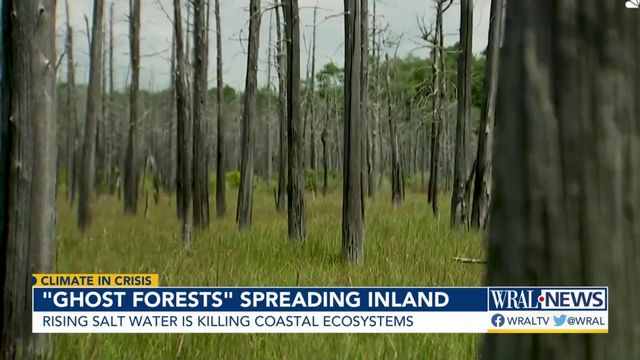The scary spread of 'ghost forests' across the east coast
Miles of dead, gray trees stretch across the east coast and throughout North Carolina's coastal communities due to saltwater creeping inland. Scientists say the speed and size of dying forest wetlands is an alarming product of climate change and rising sea levels.
Posted — UpdatedIt may sound like a Halloween attraction, but the so-called ghost forests stretching across eastern U.S. coastal communities don't need paranormal activity to be terrifying.
Scientists say the miles of gray, barren trees taking out once-healthy wetlands are a direct product of climate change.
“It’s not something that’s going to happen by 2100 and it’s not something that’s happening to polar bears far away. You can see ghost forests every time you’re driving to the North Carolina Coast. This is happening right now in our backyards,” said Marcelo Ardón, a professor and researcher at NC State who’s been studying changes to wetland forests for more than a decade.
Ghost forests aren’t a new phenomenon, but Ardón says the speed and size of the spread are alarming.
“The forests are dying faster and being replaced by marshes faster than what's ever happened before,” he said. Trees are dying due to increased salinity and more frequent flooding, exacerbated by rising sea levels.
In some areas, such as near Beaufort, the forest wetland is transitioning to a marsh ecosystem, but sometimes the forest is completely lost underwater.
“When that happens, we’re losing the important carbon sequestration of these ecosystems, so that is when it’s the worst consequence.”
The Albemarle-Pamlico Peninsula has an estimated 27 million tons of carbon stored in its trees and other biomass. Over a 35-year period, satellite imagery showed more than 10% of the area’s tree cover was taken over by ghost forests.
According to a 2020 study, the rotting trees and other ecosystem changes allowed an estimated 130,000 tons of carbon to escape into the atmosphere.
The casualties of climate change are continuing to fuel it.
Some threatened areas in North Carolina have been preserved, at least temporarily, by wetland restoration efforts.
But Ardón says this troubling trend is likely to continue. “We know that it’s happening, we know it’s getting worse, and ghost forests are likely going to continue to get worse and expand.”
Related Topics
• Credits
Copyright 2024 by Capitol Broadcasting Company. All rights reserved. This material may not be published, broadcast, rewritten or redistributed.






